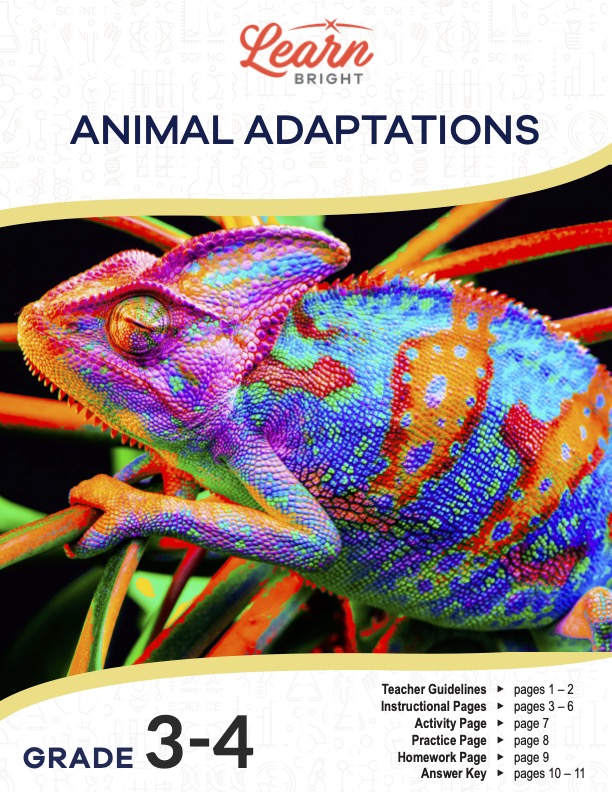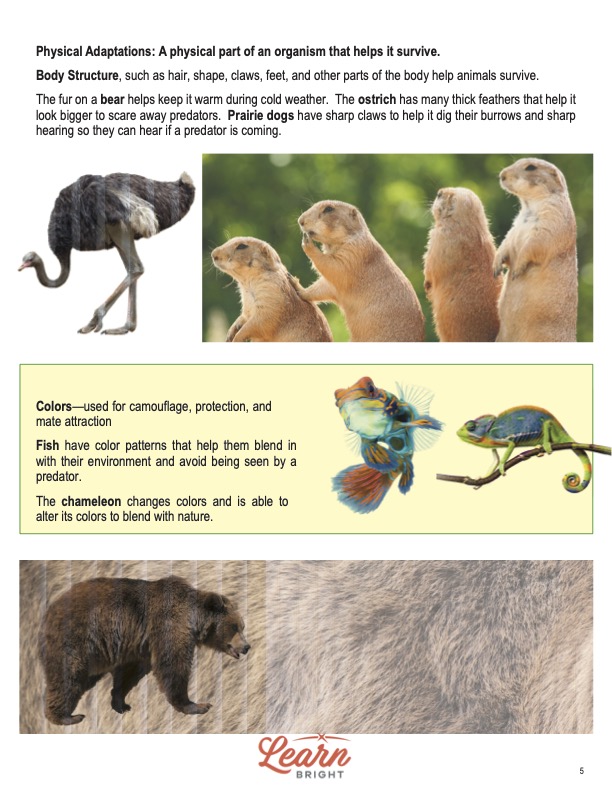Description
What our Animal Adaptations lesson plan includes
Lesson Objectives and Overview: Animal adaptations teaches students how many animals can adapt to survive. Students will learn about how certain animals hibernate, migrate, make sounds, and even dance. These are ways animals adapt behaviorally. There are also many physical and life cycle adaptations. In addition, students will discover the diverse survival techniques that allow animals to remain safe and alive in their environments. This lesson is for students in 3rd grade and 4th grade.
Classroom Procedure
Every lesson plan provides you with a classroom procedure page that outlines a step-by-step guide to follow. You do not have to follow the guide exactly. The guide helps you organize the lesson and details when to hand out worksheets. It also lists information in the yellow box that you might find useful. You will find the lesson objectives, state standards, and number of class sessions the lesson should take to complete in this area. In addition, it describes the supplies you will need as well as what and how you need to prepare beforehand. This lesson requires colored pencils, lined paper, and construction or drawing paper. You may also need to plan student pairings for the activity and set an amount of time for how long students will present for.
Options for Lesson
You will find a number of suggestions in the “Options of Lesson” section of the classroom procedure page that you can incorporate into the lesson. One such suggestion is to create a rubric for the activity from which to grade students’ work. Students can then vote for the best, most creative, funniest, and more. Another suggestion is to assign students a specific adaptation or animal to research and later present to the class. You could also show some videos that present examples of animal adaptations.
ANIMAL ADAPTATIONS LESSON PLAN CONTENT PAGES
What Is an Animal Adaptation?
The Animal Adaptations lesson plan contains four pages of content. The first page describes what an adaptation is. It presents two examples that students might relate to. When they get a low grade in a class, for instance, they might choose to study harder. When they eat something that does not taste very good, they might spit it out. And before they were born, their parents took care of them in various ways as they formed.
The lesson explains that these scenarios are examples of various adaptations. All animals and humans adapt to survive. An adaptation is a special feature or action that helps an animal live and survive in certain places or habitats. There are three types of animal adaptations: behavioral, physical, and life cycle. The three examples in the first paragraph represent each type respectively.
Animals and all other living things would not be able to survive long if they were not able to adapt. Some adaptations change over time depending on an animal’s needs. At the end, students will realize that, similarly, they sometimes have to adapt to ensure they get good grades, don’t eat bad food, and so on.
Behavioral
Behavioral adaptations include the things animals do to help them survive. One example is migration. When animals migrate, they travel to a different place to find food and survive. For instance, many birds fly south in winter months to escape the cold weather. The Arctic tern flies all the way from the North Pole to Antarctica, and monarch butterflies travel south during winter to find flowers. Hibernation is another example. Many animals hibernate during the winter, or sleep throughout the season, storing food for survival. They wake up once the temperatures warm up. Bears take long rests, but many sleep lightly. Other light sleepers are raccoons, skunks, and opossums, all of which wake up occasionally to eat. Snakes and turtles and other animals must hibernate in the ground to protect themselves from the cold because they are cold-blooded.
Many animals move a certain way to help them survive. Movement, then, is another adaptation. Bats are nocturnal animals, so flying during the day wears them out. They fly at night instead, when it’s cooler. Interactions, another category of adaptation, are the ways animals behave with each other. Honey bees dance to attract mates. They also learn from each other how to pollinate and collect honey. Another interaction is when monkeys remove parasites from other monkeys’ heads. Finally, animals use sounds to communicate. Female lions roar to protect their cubs and bird calls are used to communicate various things as well.
Physical
Physical adaptations are those that deal with a part of an organism that helps it survive. They include things like body structure and colors. Body structure includes hair, body shape, the presence of claws, feet, and other parts of the body. A bear has thick fur that keeps it warm during the winter and colder weather. An ostrich’s feathers are also very thick, which help the animal look much bigger to scare away predators. Prairie dogs have sharp claws that help them dig their burrows. They also have excellent hearing so they can hear a predator coming toward them.
When it comes to color, chameleons are not the only animal that uses color to blend in. They do change colors to blend in to their environments, but so do other animals, like fish. Fish have color patterns that help them blend in and avoid being seen by their predators.
Life Cycle
This adaptation is the process an animal goes through to help it survive. It relates to how an organism grows and develops into an adult. Frog are an excellent example of the life cycle adaptation, because they start out as tadpoles after they hatch. Atlantic salmon spend their early phase in rivers before traveling or migrating to the sea to grow and mature. Butterflies go through four stages of life. First, they start out as eggs. They change into caterpillars and later become pupae. Finally, they hatch from the chrysalis they formed as butterflies.
Key Terms
Here is a list of the vocabulary words students will learn in this lesson plan:
- Adaptation: a special feature or action that helps animals live and survive in certain places or habitats
- Migration: when an animal travels to a different place, usually during the winter
- Hibernation: when an animal sleeps during the winter season
ANIMAL ADAPTATIONS LESSON PLAN WORKSHEETS
The Animal Adaptations lesson plan contains three worksheets: an activity worksheet, a practice worksheet, and a homework assignment. The goal is for students to solidify their grasp of the material in different ways. You can refer to the classroom procedure page to know when to hand out each worksheet.
CREATE A NEW ANIMAL ACTIVITY WORKSHEET
Students will work with a partner during this activity to create a brand new animal (you are also welcome to have them work alone or in groups instead of if you wish). They will come up with a name for their animal and decide what traits and qualities it will have, such as wings, scales, legs, etc. Using scratch paper, they can draw a few rough drafts before creating a final draft.
They should include as much detail as possible. They will describe the animal’s color(s), size, and diet, as well as how it moves and eats, where it lives, who its enemies would be, and so on. They should describe the animal’s adaptations, which they can base on ones they’ve learned about or make up. They can refer to the content pages for help. Once they complete the assignment, they will present the picture of their animal and some details about it to the class.
GUESS THE TYPE PRACTICE WORKSHEET
For the practice worksheet, students will look at 12 pictures of animals. They must write down one adaptation that animal has and what type it is. For instance, they can write that bears have fur, which is a physical adaptation. They can also write that bears hibernate, which is a behavioral adaptation. Several of the pictures are of animals with multiple kinds of adaptations, so answers will vary.
ANIMAL ADAPTATIONS HOMEWORK ASSIGNMENT
The homework assignment requires students to match statements to the correct term or animal they represent. There are 12 statements total. They will then write a short explanation about an adaptation that they have as a human that they would not want to lose.
Worksheet Answer Keys
Both the practice and homework worksheets have an answer key. The answer key for the practice worksheet provides possible answers for each of the animals. It is possible some students will find adaptations that the lesson did not cover, but all of the answers on this page are from the content. The homework assignment answer key provides the answers in red. The final question will not have a universal answer, so there is no answer for it on the answer key. If you choose to administer the lesson pages to your students via PDF, you will need to save a new file that omits these pages. Otherwise, you can simply print out the applicable pages and keep these as reference for yourself when grading assignments.










